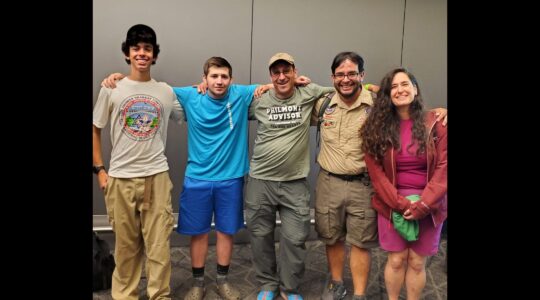BUDAPEST, Nov. 3 (JTA) Mate Koves is proud that his great-great-grandfather and great-great-uncle were renowned Orthodox rabbis.
One day Koves’ descendants may feel the same way.
The first Hungarian student at the year-old Chabad Lubavitch yeshiva in Budapest, Koves is on track to be the first Orthodox rabbi born and ordained in post-Holocaust Hungary.
Yet Koves, known among his fellow students by the Hebrew name Shlomo, is unimpressed by the achievement.
“Obviously, it’s exciting to be the ‘first,’ but I’m much more excited about the work I’ll be doing than the title,” says Koves, a slightly built, scruffy- bearded 20-year-old. “My big hope is to make Jews, especially young people, aware of Judaism. I want to be the spark that lights the candles of Jewish life.”
He clearly has his work cut out for him. The Hungarian Jewish community, while the largest in Central Europe, is also the most assimilated. Of those gradually rediscovering their Jewishness, the vast majority are drawn to a liberal stream of Judaism known here as “Neolog.”
Still, if nothing else, the fact that Koves can study at a hometown yeshiva helps to put Budapest back on the Jewish map.
“A community that opens a yeshiva shows that there is a Jewish community there, whether or not the level of Jewish learning or identity is up to par,” said Rabbi Shlomo Sherman of Los Angeles, who studied at the Chabad yeshiva last year and returned as an instructor. “It’s a source of pride for every Jew who lives in that area, because not every community can claim to have one.”
Hungarian Jews are part of a community in recovery: Until the Holocaust, there were 70 yeshivas in Hungary, scattered across the country. So, even as the launch of the Chabad yeshiva’s second year is a cause for celebration, it is also a time for mourning.
In prewar Hungary, most of the 800,000 Jews lived in the countryside, in villages, towns and small cities. They were predominantly Orthodox.
Meanwhile, one-quarter of the Jews lived in the capital, Budapest. They were generally assimilated and affiliated with the Neolog movement.
The Holocaust turned those demographics upside down. In 1944, the Germans and their Hungarian collaborators unveiled a two-stage plan: First, clear the countryside of Jews encircling the capital then target the Jews of Budapest. The first part went smoothly, as they deported 437,000 Jews in less than two months. The second phase, though, was stymied by the Soviet Union, whose Red Army liberated Hungary during the winter of 1944 and 1945.
Virtually all Jewish survivors settled in Budapest.
The more than four decades of communism that followed drove Jews away from religion and toward assimilation. Of the 100,000 or so Hungarian Jews today, the number of those affiliated with the community is estimated at 5,000 to 10,000.
Very few have memories of black hats and payes, of keeping kosher and lighting candles. For most Jews here, Neolog not Orthodox is “traditional.”
The lasting symbol of this tradition is the historic 3,000-seat Dohany synagogue, what is believed to be the second largest shul in the world. For those now reconnecting to their Judaism, Orthodox and especially fervently Orthodox Jewry is too strict, too dramatic a shift.
At another point on the spectrum, some have chosen the path of the tiny Reform movement, known as Sim Shalom. It emphasizes a flexible learning of Jewish holidays, history and traditions.
That said, there is indeed a small core of young Hungarian Jews who eagerly absorb Orthodox Judaism.
For these seekers, Chabad Lubavitch and its yeshiva fill the vacuum. They are drawn not only by the depth of learning, but by the self-confidence of a community that is not afraid to walk the streets in their black hats or to celebrate Jewish holidays in outdoor public spaces.
The yeshiva is the centerpiece of the all the work done by Baruch Oberlander, an American Lubavitch rabbi who has been based in Budapest since 1989.
The yeshiva, located downtown on a grimy side street that was a part of the Budapest ghetto, attracts plenty of foot traffic. An open house in October to herald the yeshiva’s second year drew an overflow crowd.
The yeshiva students also command respect. Neolog rabbinical students some from the newly accredited University of Jewish Studies in Budapest drop by the yeshiva for discussions on the Talmud, Torah and Chasidism. Oberlander himself routinely fields questions via e-mail.
Koves is one of 13 full-time students up from 11 last year along with seven Americans, four Israelis and a Swiss.
The foreigners say they come for the numerous opportunities to do community outreach programs and to study in a “quieter” atmosphere. Though their long days of study are marked by heated debates over Jewish law and philosophy, they say it pales to the cacophony of yeshivas in other countries with 200 students crammed in a room.
Ten years into the post-Communist transition, the Orthodox community is now approaching a “critical mass” that warrants it having its own yeshiva, Oberlander says.
A handful of young Hungarian men, like Koves, were attracted to study at yeshivas in the United States or Israel. While Koves is the first to return, more are on their way, and Oberlander says there are also 50 part-time Hungarian students who attend various classes.
“Our choice was to either start a yeshiva earlier, and lower our standards to allow more Hungarians in, or lift the Hungarians to our normal standard. We chose the latter,” says Oberlander, 33, who himself descends from a long line of Hungarian Orthodox rabbis.
“We had to build it up, stone on top of stone. We’re never going to get back to where” Hungarian Jews were “before the Holocaust, but it’d be injustice not to once again have a yeshiva here.”
JTA has documented Jewish history in real-time for over a century. Keep our journalism strong by joining us in supporting independent, award-winning reporting.





